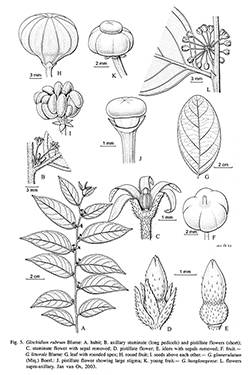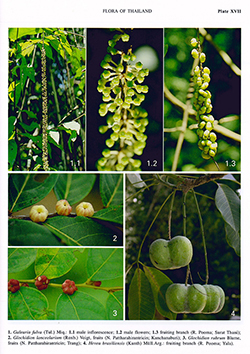e-Flora of Thailand
Volume 8 > Part 2 > Year 2007 > Page 326 > Euphorbiaceae > Glochidion
17. Glochidion rubrum Blumewfo-0000973540
Bijdr.: 586. 1825; J.J. Sm., Meded. Dep. Landb. 10: 149. 1911 (see for full synonymy); Beille in Lecomte, Fl. Indo-Chine 5: 621. 1927; Backer & Bakh.f., Fl. Java 1: 464. 1963; Airy Shaw, Kew Bull. 26: 279. 1972; Whitmore, Tree Fl. Malaya 2: 101. 1973; Welzen in Welzen et al., Thai Forest Bull., Bot. 28: 90. 2000. Fig. 5: A-F: Plate XVII: 3.
Accepted Name : Phyllanthus subscandens var. subscandens
Synonyms & Citations :
Description : Shrub to treelet, up to 5(–15) m high, dbh up to 6 cm; flowering twigs 1–2 mm thick; glabrous to hirsute all over. Leaves red when young; stipules deltoid, 3–4 by 0.8–2.2 mm, acuminate, very stiff, late caducous; petiole 1.5–3 mm long; blade (ovate to) elliptic, 2.4–9.6(–13.7) by 1–3.8(–4.8) cm, length/width ratio 1.4–2.8, chartaceous, base symmetric to asymmetric, attenuate to cuneate, margin flat, apex bluntly acuminate to sharply cuspidate, mucronate or not, upper surface (sub)glabrous, (dark) green, lower surface glabrous to hirsute, pale light green, venation flat above, slightly raised underneath, indistinct, nerves 8–10 per side, veins scalariformly reticulate. Inflorescences fascicles with a few staminate and/or pistillate flowers, usually less than 5 (to up to ca 10), staminate flowers occasionally in short(<1 cm) racemes. Flowers greenish to (yellowish) white; sepals 6, free. Staminate flowers 3.5–4.2 mm in diam.; pedicel 3.5–12 mm long, glabrous to hirsute; sepals elliptic to obovate, outer ones 2.1–2.5 by 0.9–1.2 mm, inner ones 2.1–2.2 by 0.8–1 mm; stamens 3, androecium 0.8–1.3 mm long; anthers 0.6–0.9 mm long, light yellow to grey, connective teeth 0.2–0.3 mm long. Pistillate flowers 1.5–1.7(–3) mm in diam.; pedicel absent to up to 4 mm in fruit; sepals triangular (to elliptic), outer ones 0.8–1.6 by 0.40.9 mm, inner ones 1–1.7 by 0.3–0.8 mm; ovary 3(–5)-locular, 0.9–1.5 by 0.5–1 mm high; stigmas 2.2–2.6 mm long, united except for upper third, free parts acute, sometimes constriction beneath stigmas. Fruits lobed around seeds (to around locules), circular, flattened, (slightly) depressed above in centre, 7.5–9 by 4–5 mm red, sutures indistinct, always hairy, glabrescent; wall thin; column 2.5–3 by 1.5–2 mm, only narrow basal triangle left. Seeds 3.8–4 by 3.3–3.8 by ca 2.5 mm, orange to red.
Thailand : NORTHERN: Mae Hong Son, Chiang Mai, Chiang Rai, Tak; EASTERN: Nakhon Ratchasima, Si Sa Ket, Ubon Ratchathani; SOUTH-WESTERN: Kanchanaburi; SOUTH EASTERN: Trat; PENINSULAR: Ranong, Surat Thani, Phangnga, Phuket, Krabi, Nakhon Si Thammarat, Phatthalung, Trang, Satun, Songkhla, Narathiwat.
Distribution : Burma, Indochina, throughout Malesia (Java – type) up to the Maluku and Lesser Sunda Islands.
Ecology : Rare to locally common in evergreen forests, secondary forests, deciduous forests, open Melaleuca forests, open thickets; along roads, streams, forests edges, peat swamp edges, ridges; soil: may be silty, rocky, clay shale, sandy podsolic, limestone; sea level up to 500(–2,175) m alt.
Vernacular : Tana (ตานา)(Nong Khai); kradum phi (กระดุมผี)(Rayong); ma ruat (มะรวด)(Surat Thani); khatna (ขัดนะ)(Trang); nok non (นกนอน)(Narathiwat); kue-nong (กือนอง)(Malay-Peninsular).
Notes: The former Glochidion leiostylum has a somewhat different appearance, because it mainly flowers along the leafless parts of axes (leaves fallen off), but there is no other distinguishing character.


